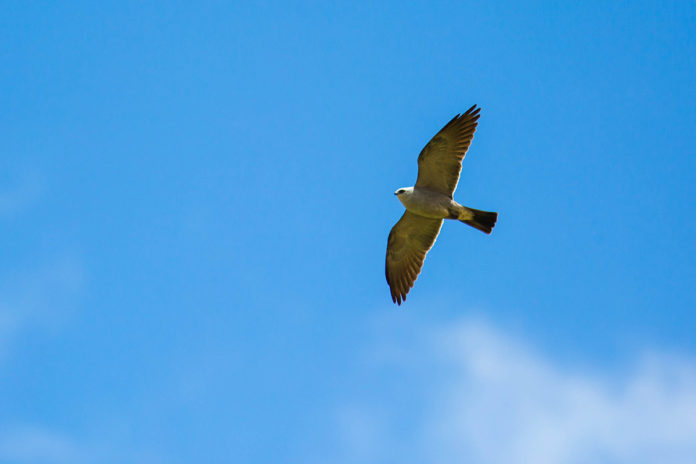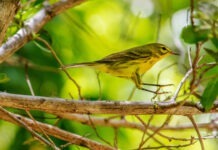The sequence of events was this: I was riding my bike through the cemetery, I saw a couple of birds, I got a Toni Basil song stuck in my head. This was unexpected but also, in certain ways, largely predictable.
I entered the cemetery via Frances Street, the entrance the sexton tried to close off a couple years ago to keep out the riff raff, passed the elongated Captain Outrageous plinth with its crouching fairy-angel on top, then the Otto family plot with all the bricks, the small statue of their pet Key deer, and the headstone over their pet Yorkie, which had my wife’s favorite epigraph, “His little spirit was a challenge to love.” I scared a few iguanas and watched them scurry into the crypts, dodged an oncoming car that was not inclined to share the road, and was heading toward the turn that would go by the USS Maine memorial, when I saw it.
It’s the first American kestrel of the season, I thought, though before I even finished thinking it, I knew it wasn’t quite right. The bird had the pointed wings, and at first glance it was sort of in the same size range, but American kestrels have this mixture of lightness and intensity when they fly that comes across as part windblown leaf, part bullet.
I thought briefly about the next biggest falcon we get in the Keys, the merlin, but a merlin’s flight pattern is also part windblown leaf, part bullet, if you skip the windblown leaf part, and that also didn’t match. Then I thought about the Peregrine falcons, but this bird wasn’t bulky enough and didn’t have the commanding musculature of the fastest animal on the planet.
I stopped my bike and just watched the thing loop slowly overhead. The bird was backlit and in silhouette. Binoculars would have been useful.
The loops were kind of effortless, imbued with a casual elegance, a poised refinement you don’t always see in falcons. Still though, the pointed wings … and I bounced around in the search pattern in my head, trying to cram an octagonal peg into a round hole, before I realized I was experiencing a very specific deja vu.
I’d felt that exact confusion before, specifically while standing in a field on Long Point Key about 15 years before, the first time I’d seen one of these birds, and pretty much every time I saw my first one at the beginning of the migration season. Sure, pointed wingtips are diagnostic on a falcon, but the wings were lankier, the tail longer, which brought about the sense of mellow figure-skater grace.
It was a Mississippi kite.
Mississippi kites are middle-of-the-country birds, breeding in the Great Plains, along the Mississippi River, and a smattering of other places, including the Florida Panhandle. There’s a population of about 200,000 to 250,000, and in the fall, the vast bulk of them migrate through Mexico and Panama to South America. But a small handful every year take the Keys route. They count an average of 57 Mississippi kites every year at the Florida Keys Hawkwatch. (They count an average of 5,378 falcons.)
Mississippi kites’ flight patterns tend to be less aggressive than those of falcons because they don’t attack their prey – which consists mostly of insects, lizards and the occasional slow-witted songbird – so much as pluck it unsuspecting from tree branches and shrubs, or in midair. Which is not to say they are gentle creatures. Alexander Wilson, who first described the species to science in the 1800s, described handling an injured Mississippi kite and having it talon him to the bone.
There’s a shorthand that birders use called bander’s codes (properly called alpha codes) – four letter abbreviations for bird names. Instead of writing out m-a-g-n-i-f-i-c-e-n-t f-r-i-g-a-t-e-b-i-r-d in your notebook, you write MAFR. It’s a real time saver, and if you hang around with birders enough, you’ll start to hear them out loud – a mourning dove is a MODO, a Peregrine falcon is a PEFA, a black-throated blue warbler is a BTBW. There’s an official list organized and updated every year by the America Ornithological Society, but delving into it feels akin to reading tax law. They’re largely intuitive anyway, so I mostly wing it, though I have looked at codes I’d written down years before in old notebooks and had no idea what bird I was talking about.
The Mississippi kite is as straightforward as it gets: MIKI.
Toni Basil has had a long and illustrious career as a dancer and choreographer, working with David Byrne, David Bowie and several famous people not named David. (Her Wikipedia page is chock full of surprising facts, including that she choreographed all the crazy moves in the Talking Heads “Once in a Lifetime” video. Same as it ever was…) And there was a video that went viral a couple years ago of the then 74-year-old Basil busting a long series of age-defying dance moves. (It is impossible not to be impressed. See markhedden.com/notes for a link.)
But anyone who had MTV in the early 1980s most likely knows Toni Basil from her high-energy, cheerleader-themed, one-hit-wonder hit, “Hey Mickey.” And standing there in the cemetery, watching the Mississippi kite slowly rise up and over the horizon, I knew there was no way to not hear her relentless earworm chant of the chorus stuck in my head…
Oh MIKI / you’re so fine
you’re so fine you blow my mind
Hey MIKI / Hey MIKI
It wasn’t a bad thing to have stuck there. And it was true. Which is good, because I knew I was going to be living in that moment for the rest of the day.


























